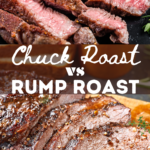When it comes to cooking up a delicious roast beef, understanding the differences between cuts of beef like chuck roast vs rump roast is super important. Both are tough meat but a good choice for slow cooking methods at a low temperature, making them tender… And both are excellent options for a classic pot roast.

Chuck Roast vs Rump Roast
Boneless Chuck Roast
- Cut and Names: Chuck roast is often referred to as “7-bone chuck roast” because of the shape of the bone within it. It’s also known as “shoulder roast” or “chuck roll.” A chuck roast can also be referred to as an “arm roast.” Chuck is a large primal cut of beef, and it contains various sub-cuts, including the arm roast. So, when you see the term “arm roast,” it typically means a cut of meat that comes from the chuck portion of the beef.
- Toughness: Chuck roast is a tougher cut of meat due to the presence of a lot of connective tissue, but it can be transformed into tender, flavorful meat when slow-cooked properly.
- Cooking Method: Chuck roast is a prime candidate for slow cooking methods like the slow cooker, crock pot, or Dutch oven. Low temperatures over a long period of time help break down the collagen, resulting in tender meat. A typical 3 to 4-pound chuck roast will usually take about 4 to 5 hours on the high setting in a crock pot to become tender and easily shreddable or “fall apart” delicious.
- Flavor: Chuck roast has a higher fat content compared to rump roast, which adds to its rich flavor.
Rump Roast
- Cut and Names: Rump roast, goes by different names, sometimes called “beef rump roast,” is derived from the back leg of the cow and is a lean meat.
- Toughness: While rump roast is leaner, it’s still considered a tougher cut and benefits from slow cooking to become tender.
- Cooking Method: Rump roast can be cooked using similar methods as chuck roast, such as the slow cooker, Dutch oven, or even the instant pot. Cooking at lower temperatures is key to achieving the best results. Rump roast, being a leaner cut, can cook a bit faster than chuck roast. A 3 to 4-pound rump roast may take approximately 3.5 to 4.5 hours on the high setting in a crock pot to reach the desired tenderness and become easy to pull apart.
- Flavor: Rump roast tends to have a milder flavor compared to chuck roast due to its lower fat content.

Differences
Chuck Roast
- Contains more fat and connective tissue, resulting in richer flavor.
- Beneficial for slow cooking methods like the slow cooker or Dutch oven.
- Requires longer cooking times to become tender.
- Ideal for classic pot roasts and beef stews.
Rump Roast
- Rump roast is a leaner cut of meat, and less marbled, offering a milder flavor.
- Also suitable for slow cooking techniques such as the slow cooker or instant pot.
- Cooks more quickly due to its lean nature… It’s also tender cooked to rare or medium rare if it is sliced THIN and against the grain.
- Rump Roast is a good choice for those seeking a leaner, healthier option.

Nutritional Comparison
Rump Roast (3 ounces, cooked)
- Calories: Approximately 143 calories
- Protein: Around 24 grams
- Total Fat: About 5 grams
- Saturated Fat: Approximately 2 grams
- Monounsaturated Fat: About 2 grams
- Polyunsaturated Fat: Less than 1 gram
- Cholesterol: Approximately 62 milligrams
- Iron: About 2 milligrams (11% of the Daily Value)
- Zinc: Approximately 4 milligrams (27% of the Daily Value)

Chuck Roast (3 ounces, cooked)
- Calories: Approximately 215 calories
- Protein: Around 24 grams
- Total Fat: About 13 grams
- Saturated Fat: Approximately 5 grams
- Monounsaturated Fat: About 5 grams
- Polyunsaturated Fat: Less than 1 gram
- Cholesterol: Approximately 78 milligrams
- Iron: About 2 milligrams (11% of the Daily Value)
- Zinc: Approximately 4 milligrams (27% of the Daily Value)
Best Rump vs Chuck Cooking Methods

Best Ways to Cook Rump Roast
- Slow Cooking (Crock Pot or Oven): Rump roast responds well to slow cooking methods. Season the roast, sear it in a hot pan if desired, then place it in a crock pot or oven at a low temperature (around 250°F or 120°C) for several hours until it’s tender and easily shreds with a fork.
- Instant Pot or Pressure Cooker: You can also cook rump roast in an Instant Pot or pressure cooker for faster yet tender results.
- Roasting (Oven): For a more traditional roast, you can cook rump roast in the oven at higher temperatures (around 350°F or 175°C) for a shorter time, usually around 20-25 minutes per pound.
Best Ways to Cook Chuck Roast
- Slow Cooking (Crock Pot or Dutch Oven): Chuck roast is ideal for slow cooking methods. It’s often used for classic pot roasts and beef stews. Sear the meat first for enhanced flavor, then slow-cook it in a crock pot or Dutch oven at a low temperature (around 250°F or 120°C) for several hours.
- Braising (Stovetop or Oven): Braising involves searing the chuck roast, then cooking it in a flavorful liquid (like broth, wine, or tomato sauce) in a covered pot on the stovetop or in the oven.
- Smoking or Grilling (Optional): While less common, some people smoke or grill chuck roast for added flavor. This method is often used for dishes like smoked or barbecued beef brisket.

Rump Roast vs Chuck Roast Cooking Tips
The best way to cook these, for both cuts, start by bringing the meat to room temperature before cooking for 3 reasons:
- Even Cooking: When meat is at room temperature, it cooks more evenly. If the meat is very cold when you start cooking, the exterior may cook more quickly than the interior, leading to an uneven result with overcooked or undercooked parts.
- Reduced Cooking Time: Room-temperature meat requires less time to reach the desired internal temperature when it’s placed in a hot cooking environment.
- Improved Maillard Reaction: Allowing the meat to come to room temperature can also enhance the development of the Maillard reaction, which is responsible for the browning and development of rich, savory flavors on the meat’s surface during cooking.
Searing
Searing your beef roast before it slow cooks is best for a few reasons:
- Maillard Reaction: The high heat while searing triggers the Maillard reaction, a complex chemical process that occurs between amino acids (proteins) and reducing sugars in the meat. This reaction creates a rich, brown crust on the meat’s surface, resulting in enhanced flavor and color.
- Improved Texture: The searing process also helps create a pleasing texture on the exterior of the meat. The high heat causes the proteins in the meat to denature and form a crust, which can contrast nicely with the tender interior when you slow-cook the meat.
- Flavor Development: Searing not only adds depth of flavor through the Maillard reaction but also helps to develop and intensify the meat’s existing flavors. It can lock in some of the meat’s natural juices, contributing to a juicier final result.
- Aesthetic Appeal: Searing also gives the meat an attractive appearance. The beautifully browned surface creates an appealing presentation.
Resting
Wrap the roast in aluminum foil and allow it to rest for a few minutes after cooking to retain its juices.
Resting the meat, even after extended slow cooking, allows the juices to evenly distribute throughout the roast, ensuring that each slice remains moist and flavorful.
Personal Preference
The choice between chuck roast and rump roast often comes down to personal preference. Chuck roast offers more flavor due to its higher fat content, while rump roast is a leaner option. Both can be turned into tender, delicious dishes with the right cooking process.
Whether you opt for chuck roast or rump roast, slow cooking at lower temperatures is the perfect way to transform tough cuts of meat into tender, flavorful roast beef. Experiment with different methods and seasonings to find your perfect rump roast or chuck roast recipe!
Sources

About Juliea
Juliea Huffaker is the creator of Farmhouse Harvest, and dedicated to teaching from-scratch cooking, sourdough baking, gardening, and food preservation. With over 25 years of hands-on experience she has preserved hundreds of jars of produce, mastered the art of meats and sourdough baking, and nurtured a thriving organic garden. Her recipes and articles have been featured across the web. And she’s passionate about inspiring others to embrace a simpler, self-sufficient life style.








